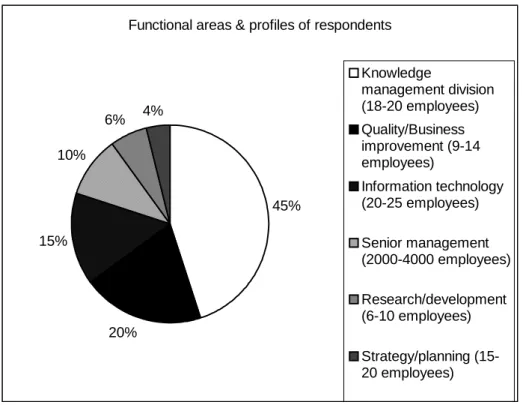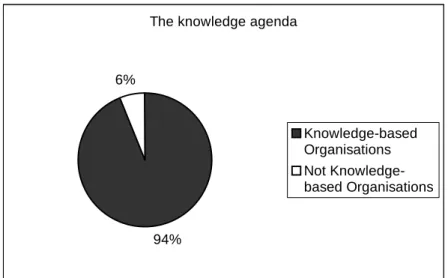Knowledge management is a business process that combines knowledge, people, processes, strategies, techniques and technologies. When implementing a knowledge management initiative, the knowledge management strategy is closely linked to the overall business strategy.
Introduction
Provide knowledge management capabilities and knowledge architecture to support active knowledge management as part of the organization's practices and culture. Such knowledge is essential for successful learning and innovation (or knowledge creation) in an organization.

Problem statement and objectives of the research
To find out the current state of knowledge management implementation in industry in South Africa, with a particular focus on financial organisations. A literature review revealed that financial organizations ranked first among the leading knowledge-using industries.
Research methodology
Although the first generations of knowledge management solutions (solutions usually combine several techniques and technologies) focused on explicit knowledge in the form of meetings, documents and databases, there is a trend to expand the scope of solutions to integrate techniques and technologies that can promote the use of tacit knowledge (Davenport and Prusak, 1998: 96).
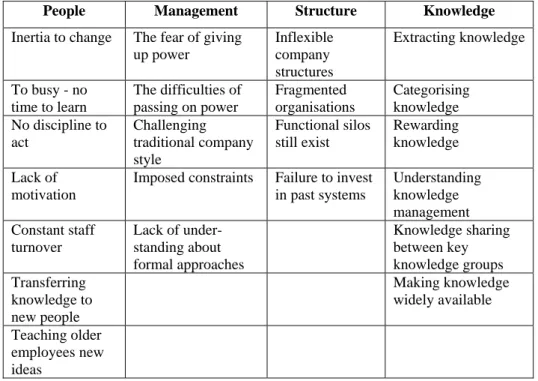
Demarcation of study
Division of chapters
Knowledge management is defined and the current state of knowledge management in organizations is discussed. Finally, the distinction and relationship between organizational learning and learning organization is discussed and the learning organization and learning in organizations are placed in a knowledge management context.
KNOWLEDGE AS A CONCEPT
Introduction
Drucker's (1993) oft-repeated statement that "knowledge has become the most important economic resource and the dominant and perhaps even the only source of competitive advantage" emphasizes the urgency of taking knowledge seriously. As the world begins to fill with "knowledge workers" who create and share knowledge in new ways within knowledge-based businesses, the global economy looks very different than it did just a decade ago.
The knowledge era
Several new perspectives on the value of knowledge and capital have emerged in business, such as knowledge assets, knowledge capital, and knowledge value added. The only thing that gives an organization a competitive advantage—the only thing that is sustainable—is what it knows, how it uses what it knows, and how quickly it can know it.
Data, information and knowledge
Information and knowledge can be seen as closely linked in complementary stages along the same path. According to the above authors, data, information, knowledge and wisdom can be seen as a coherent whole, each is followed by the other, and the degree of human involvement divides the concepts.
Types of knowledge
- Personal knowledge
- Public knowledge
- Shared knowledge
- Organisational knowledge
Actual knowledge is acquired from memory and is knowledge of what people "know to be true". Knowledge is shared between groups and communities through shared experiences and knowledge transfer, both tacit and explicit.
Knowledge creation and knowledge conversion processes
- From tacit to tacit
- From tacit to explicit
- From explicit to explicit
- From explicit to tacit
Part of one's tacit knowledge becomes part of the other's own tacit knowledge base. Thus, it becomes part of the tacit knowledge base in the form of shared mental models or technical know-how and becomes valuable knowledge.
Knowledge as an intangible asset
- New measures for knowledge assets
- The economic value of knowledge
It is a relevant perspective when we think about the economy and value of knowledge – how knowledge is created, made available, traded and exchanged. When knowledge is used to create products and services, knowledge is not depleted in the same way as other resources.
The use of knowledge in organisations
In recent decades, all work with knowledge-related activities and the people involved in them has shown a lack of understanding of what knowledge is, how it is used and how it can be managed. Knowledge professionals try to do their best, but need additional insights before understanding what knowledge is, how it is used and what can be done to improve current situations and practices.
Summary
THE THEORY OF KNOWLEDGE MANAGEMENT
Introduction
In today's fast-paced society, an organization's knowledge base is fast becoming its only sustainable competitive advantage. An overview is given of what a "knowledge-based organisation" exactly is, as well as a discussion of the driving forces behind knowledge management.
Knowledge management defined
Knowledge management as a concept is defined, the current state of knowledge management is discussed, and the relationship between knowledge management and information management is described. Knowledge management is the conception of an organization as an integrated system of knowledge, and the management of the organization for the effective use of this knowledge.
The current state of knowledge management
What can be managed is not knowledge, but the space and the enabling environment in which the processes of knowledge creation, sharing and application take place.
The relationship between knowledge management and information
The absence of an adequate data and information management program can lead to the failure of a knowledge management program. Thus, success in a knowledge management program requires the integration and management of data, information and knowledge within the organization.
The knowledge-based organisation
Organizations that thrive on knowledge management will be those that realize that it is as much about people as information. Sveiby (1993) stands out as one author who provided a practical foundation for knowledge-based organizations.
Driving forces behind knowledge management
- Realisation of the changing role of knowledge
- Cost avoidance
- The leverage of knowledge in enabling corporate success
- Value and measurement of intangible assets
- Globalisation of business and international competition
- Sophisticated customers, competitors and suppliers
Less easy to identify is the knowledge that is used day in and day out during the normal business operations of an organization - the knowledge that is in people's heads. Stock market analysts have traditionally often tied the value of companies to their tangible assets.
Principles of knowledge management
- Knowledge management is expensive
- Effective knowledge management requires hybrid solutions of people
- Knowledge management requires leadership
- Knowledge management benefits more from maps than models, more
- Sharing and using knowledge are often unnatural acts
- Knowledge management means improving knowledge work processes 54
- Knowledge management never ends
- Knowledge management requires a knowledge contract
One of the reasons that knowledge management never ends is that the knowledge required is always changing. As knowledge becomes a more valued resource, organizations can expect more attention to the legitimacy of knowledge management (Davenport, 2001).
Advantages of knowledge management
The organization's infrastructure and business processes cannot be neglected when implementing knowledge management.
Barriers of knowledge management
Knowledge management activities
Creating intelligent capabilities where useful knowledge external to the organization is harnessed and used to inform strategic decision-making. Developing an understanding of the knowledge capabilities that the organization will need to compete in the future.
Approaches to knowledge management
First, the middle-up-down style for successful knowledge management will be explored, followed by the people-centered approach versus the technology-centered approach. Grayson (1995) explains it very clearly: "If knowledge management is not central to the strategy of an organization, it is unlikely to go anywhere."
Summary
The principles of knowledge management summarize many of the challenges that knowledge-based organizations face. The study side is related to people management as people are the primary source of knowledge and technology is a secondary source and as a medium to store knowledge transferred from people.
ORGANISATIONAL LEARNING AND KNOWLEDGE
Introduction
Therefore, knowledge management and organizational learning may work better as interrelated and overlapping concepts, rather than assumed as synonyms for the same. An overview of organizational learning will then be provided, covering the following aspects: definitions of organizational learning, principles of organizational learning, the context of organizational learning and learning in organizations.
The relationship between learning, knowledge and change
Pedler argues that there is no universally accepted definition of learning, but one way of putting it is that learning is about "how people change". Learning is understanding, it is a process that leads to knowledge (Burgoyne, Pedler & Boydell, 1996: 12).
Organisational learning
- Definitions of organisation learning
- Principles of organisational learning
- The organisational learning context
- Organisational culture
- Organisational structure
- Organisational infrastructure
- Learning in organisations
- Individual learning
- Group or team learning
- Organisational learning
- Types of learning
- Adaptive learning
- Deutero learning
- Action learning
Organizational learning is the increase of the organization's learning capacity (speed, depth and breadth of learning) (Marquardt, 1996: 22). According to Marquardt, one of the most valuable tools for organizational learning is action learning.
The learning organisation
- Definitions and characteristics of learning organisations
- Learning organisations versus traditional organisations
- Advantages of a learning organisation
- Learning organisation frameworks and models
According to Hitt, a learning organization is an organization that is striving for excellence through continuous organizational renewal. Systems thinking clarifies many aspects of the organization of learning—the new way in which individuals perceive themselves and their world.
Organisational learning versus learning organisation
In summary, a learning organization includes five different subsystems – learning, organization (structure), people, knowledge and technology. In summary, a learning organization responds to changes in the environment through proactive organizational learning; moreover, it deliberately strives to improve his ability to learn.
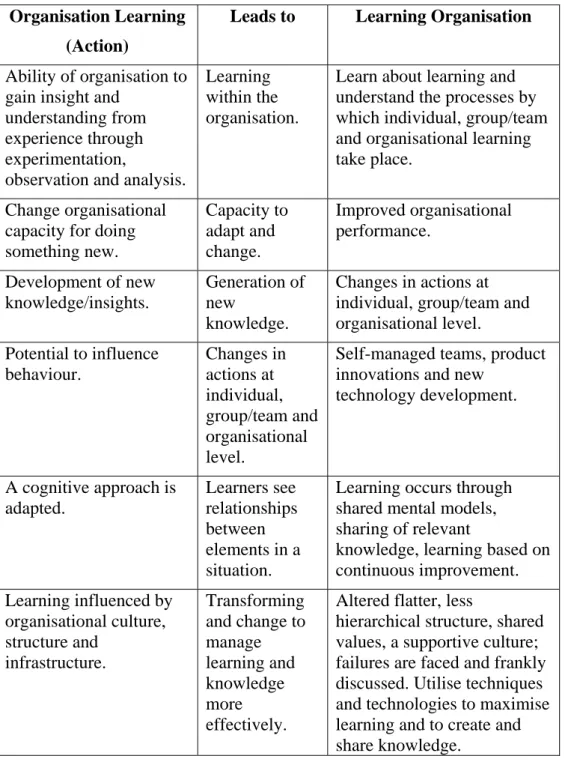
Summary
There are many different models of the learning organization in the literature, each with similarities to other models, yet no two are exactly alike. Five core elements or subsystems are identified by most authors in their frameworks or models of a learning organization: organizational strategy, knowledge and learning, people and technology.
TECHNIQUE AND TECHNOLOGY SUPPORT FOR
Introduction
The previous chapter closely linked knowledge management with the concepts of organizational learning and learning organizations. So while IT is a great enabler to support knowledge management processes, it is not the only tool or solution available.
The role of knowledge management techniques and technology
- People as an essential component of the knowledge transfer process
- Processes as an essential component of the knowledge transfer process
- Techniques and technology as an essential component of the knowledge
The value of this model in the current context of knowledge management is that it focuses attention on tacit knowledge (which is represented in three of the four processes) and thus on people and their knowledge. In summary, we have discussed the role of techniques and technologies that contribute to knowledge management solutions using Nonaka and Takeuchi's model of organizational knowledge creation as a framework.
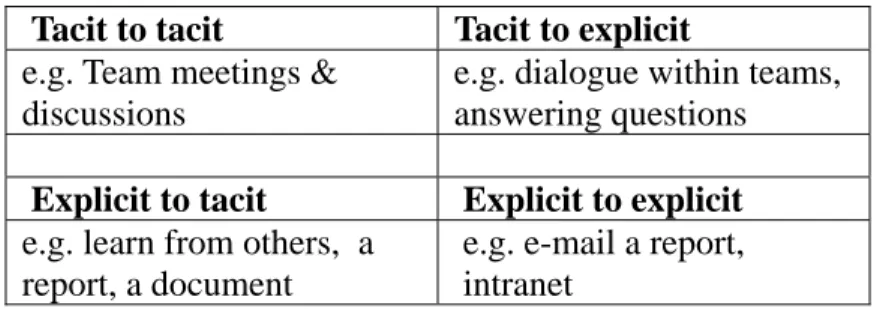
Techniques to support knowledge management
- Talk rooms and knowledge fairs
- Mentoring
- Stories and storytelling
- Breakfast chatting
- Communities of practice
- Suggestion schemes
- Face-to-face conversations
Changes in the organization affect the relative importance of the community and place new demands on it. These members regularly attend meetings and occasionally participate in community forums, but without the regularity or intensity of the core group.
Technology to support knowledge management
- The need for knowledge management technology
- Knowledge management technology architecture
- Characteristics of knowledge management technology
- Current and future technologies
- Enabling technologies
- Technologies available in the marketplace
- Technologies to consider in the future
The basic layer of the knowledge management system includes a knowledge repository as well as unstructured and structured data sources. There is no single technology architecture solution to support all the requirements of a knowledge management project.
Summary
Nonaka and Takeuchi have classified the role of techniques and technologies in knowledge management according to the notions of tacit and explicit knowledge. Any knowledge management initiative requires equal attention to the various components of knowledge management, namely strategy, people, processes and techniques, and technology.
KNOWLEDGE MANAGEMENT IMPLEMENTATION
- Introduction
- Success factors of a knowledge management implementation
- Visible short-term success indicators of knowledge management
- Possible long-term benefits of knowledge management implementation
- Interdependency between business strategy and knowledge
- Management of the organisation
- Management of the people
- Management of the processes
- Management of the infrastructure
- Summary
The four descriptive frameworks emphasize the adaptation of the knowledge management strategy to the business strategy (Bhatt, 2000;. The application of knowledge is still dependent on the organization's knowledge workers and emphasizes the critical role the human element plays in the implementation of the knowledge management initiative.
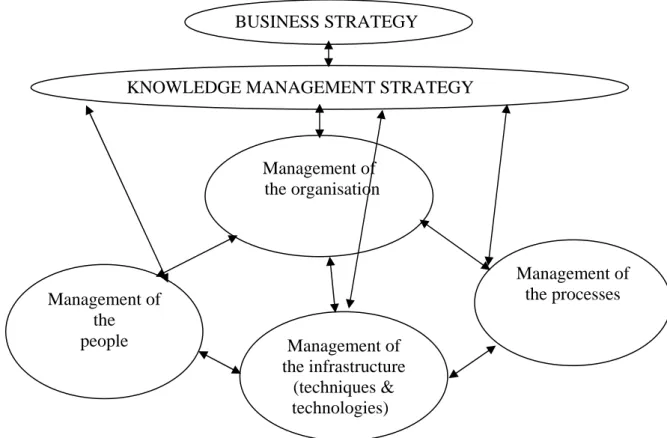
KNOWLEDGE MANAGEMENT IN THREE FINANCIAL
- Introduction
- The organisations: features, environments and functions
- Financial organisation A (FOA)
- Financial organisation B (FOB)
- Financial organisation C (FOC)
- Discussions and findings of survey outcomes
- Functional areas of respondents
- Perception of knowledge management
- The knowledge agenda
- Current stage of engagement with knowledge management
- Reason for investing in knowledge management
- The most valuable feature of a knowledge management solution
- Position of a Chief Knowledge Officer
- Barriers to the widespread application of knowledge management
- Costly mistakes due to insufficient knowledge or experience
- Kind of environment to maximise gaining, sharing and utilising
- Component technologies that will make significant contributions to a
- Component techniques that will make significant contributions to a
- Conclusions
Only 4% of respondents reported investing in knowledge management because their competitors did. Each of the three organizations interpreted the most valuable feature of a knowledge management solution differently.
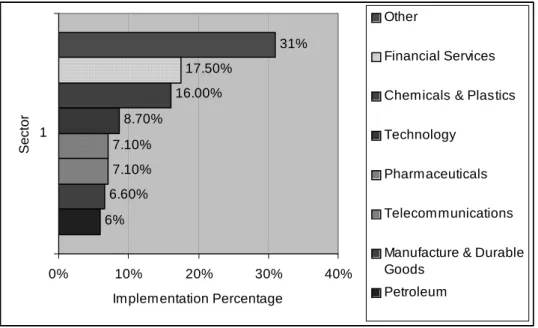
CONCLUSION
Introduction
Findings
Three financial organizations were used in case studies to explore the current state of knowledge management implementation initiatives. Although technology can support knowledge management, it is not the starting point of a knowledge management initiative.
